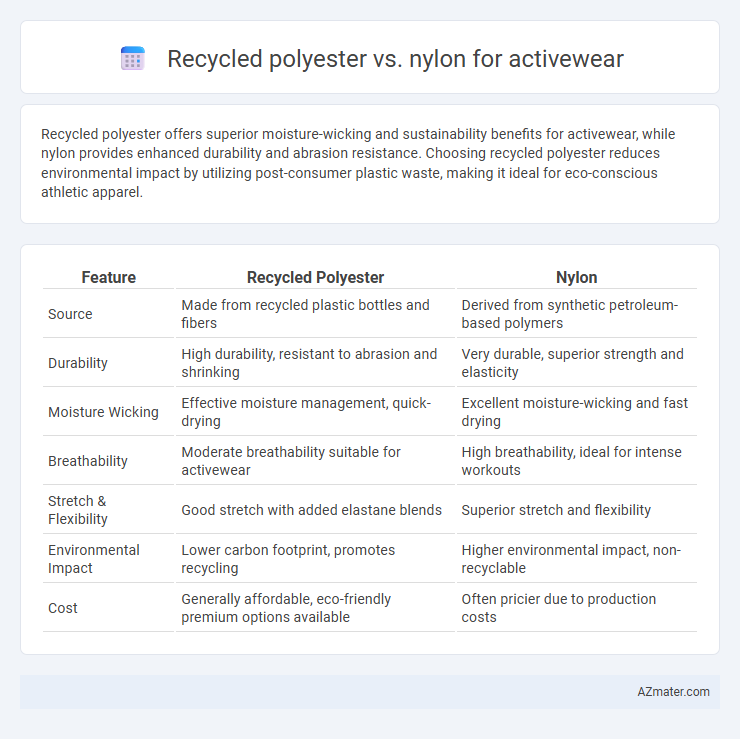Recycled polyester offers superior moisture-wicking and sustainability benefits for activewear, while nylon provides enhanced durability and abrasion resistance. Choosing recycled polyester reduces environmental impact by utilizing post-consumer plastic waste, making it ideal for eco-conscious athletic apparel.
Table of Comparison
| Feature | Recycled Polyester | Nylon |
|---|---|---|
| Source | Made from recycled plastic bottles and fibers | Derived from synthetic petroleum-based polymers |
| Durability | High durability, resistant to abrasion and shrinking | Very durable, superior strength and elasticity |
| Moisture Wicking | Effective moisture management, quick-drying | Excellent moisture-wicking and fast drying |
| Breathability | Moderate breathability suitable for activewear | High breathability, ideal for intense workouts |
| Stretch & Flexibility | Good stretch with added elastane blends | Superior stretch and flexibility |
| Environmental Impact | Lower carbon footprint, promotes recycling | Higher environmental impact, non-recyclable |
| Cost | Generally affordable, eco-friendly premium options available | Often pricier due to production costs |
Introduction: Recycled Polyester vs Nylon in Activewear
Recycled polyester and nylon are prominent sustainable materials in activewear, each offering unique performance benefits. Recycled polyester, derived from post-consumer plastic waste, provides moisture-wicking properties and durability while reducing environmental impact. Nylon, often engineered from recycled sources, delivers superior elasticity, abrasion resistance, and quick-drying capabilities essential for high-intensity workouts.
Material Origins: How Recycled Polyester and Nylon Are Made
Recycled polyester is made from post-consumer plastic bottles or industrial polyester waste, which undergoes melting and extrusion to produce fibers that retain the durability and moisture-wicking properties ideal for activewear. Nylon, traditionally derived from petrochemicals through a polymerization process of caprolactam, can also be recycled from fishing nets or fabric scraps to reduce environmental impact while maintaining its strength and elasticity. Both materials leverage circular economy principles by transforming waste into high-performance textiles, meeting sustainability demands in activewear markets.
Environmental Impact: Sustainability Comparison
Recycled polyester for activewear significantly reduces environmental impact by utilizing post-consumer plastic waste, lowering greenhouse gas emissions by up to 75% compared to virgin polyester production. Nylon, particularly recycled nylon, also offers sustainability advantages by diverting fishing nets and industrial waste from oceans and landfills, decreasing carbon footprint by approximately 40%. However, recycled polyester generally requires less water and energy in manufacturing than nylon, making it a more sustainable choice for eco-conscious activewear brands.
Moisture-Wicking and Breathability Performance
Recycled polyester excels in moisture-wicking due to its hydrophobic properties, drawing sweat away from the skin to keep activewear dry and comfortable during intense workouts. Nylon offers superior breathability with a lightweight, porous structure that enhances airflow and reduces heat buildup, ideal for high-activity conditions. Comparing both, recycled polyester provides better sweat management while nylon delivers enhanced ventilation, making them complementary choices depending on specific activewear performance requirements.
Durability and Strength in Athletic Use
Recycled polyester offers excellent durability and resistance to abrasion, making it ideal for activewear designed to withstand frequent use and vigorous movement. Nylon, known for its superior tensile strength and elasticity, also excels in retaining shape and resisting tears during intense athletic activities. Both materials provide robust performance in sportswear, but nylon typically surpasses recycled polyester in overall strength and stretch recovery.
Comfort and Texture: Wearability Differences
Recycled polyester offers a soft, smooth texture with excellent moisture-wicking properties, making it ideal for activewear designed for prolonged comfort and breathability. Nylon provides a slightly silkier feel and greater elasticity, enhancing durability and stretch for high-performance activities. Both materials balance comfort and wearability, but recycled polyester excels in lightweight softness, while nylon delivers superior resilience and a sleek finish.
Stretch and Flexibility for Movement
Recycled polyester and nylon both offer excellent stretch and flexibility essential for activewear, but recycled polyester typically provides superior moisture-wicking capabilities and durability. Nylon is known for its exceptional elasticity and recovery, making it ideal for high-movement activities requiring sustained flexibility. The blend of recycled polyester with elastane enhances stretch retention while reducing environmental impact, making it a preferred choice for eco-conscious activewear brands.
Cost Comparison: Affordability for Brands and Consumers
Recycled polyester is generally more affordable than recycled nylon, making it a preferred choice for activewear brands aiming to balance sustainability with cost-effectiveness. The production of recycled polyester often requires less energy and fewer raw materials, resulting in lower manufacturing expenses passed on to consumers. While recycled nylon offers superior durability and elasticity, its higher price point can limit accessibility for budget-conscious brands and shoppers.
Care, Maintenance, and Longevity
Recycled polyester offers excellent durability and moisture-wicking properties, making it easy to care for with simple machine washing and quick drying, which enhances its longevity in activewear. Nylon, while also strong and abrasion-resistant, typically requires more careful maintenance to prevent damage from heat and harsh detergents, impacting its lifespan. Both materials benefit from cold water washes and air drying to maintain fiber integrity and color vibrancy over extended use.
Which Material Is Best for Your Activewear Needs?
Recycled polyester offers superior moisture-wicking and breathability, making it ideal for high-intensity workouts, while nylon provides exceptional durability and abrasion resistance suited for rugged activities. Both materials are lightweight and quick-drying, but recycled polyester has the added benefit of being more eco-friendly due to its sustainable production process. Choosing the best fabric depends on your activewear needs: prioritize recycled polyester for comfort and environmental impact, and nylon for strength and long-lasting performance.

Infographic: Recycled polyester vs Nylon for Activewear
 azmater.com
azmater.com